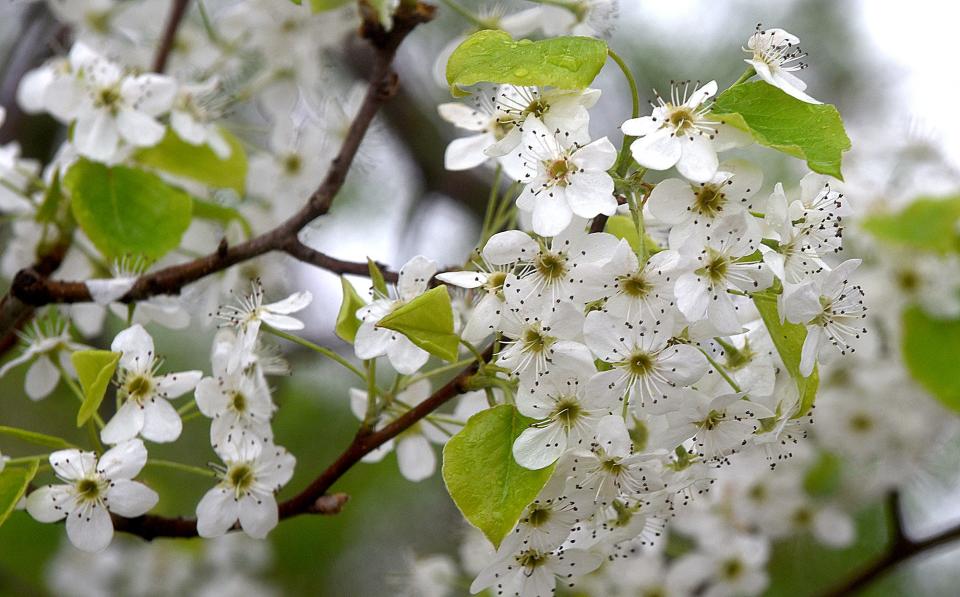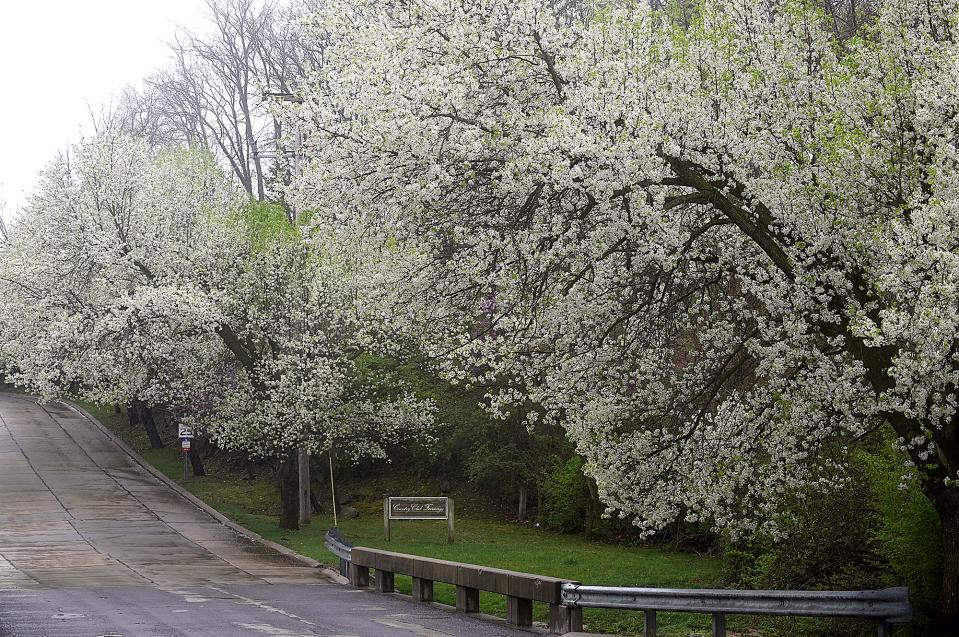Bradford pear trees are still wreaking havoc in central Missouri. Here's what you can do.
A Bradford pear tree can be a beautiful sight to behold. But that's about where its usefulness ends.
The Bradford pear, also known as the Callery pear, can create unpleasant smells and, more importantly, is invasive and destructive to other plants and animals.
It multiplies quickly and crowds out Missouri native plants, according to the Missouri Department of Conservation.
“The Callery pear became a popular ornamental landscape tree in the 1960s because it was inexpensive, it grew fast, and provided those eye-catching blooms in the spring,” said MDC Forestry Program Supervisor Russell Hinnah. “But that’s where its benefits end. Different varieties of the tree were planted close to each other, which resulted in cross pollination and they took over natural areas.”
The Bradford pear also has a poor branch structure. The trees don’t fare well in storms, often losing limbs or splitting apart.
MDC encourages homeowners and landscapers to grow native when picking a tree to plant.
“The best option is to select species native to Missouri, and there are many great trees to substitute,” said Hinnah. “Serviceberry trees produce similar showy white blooms in the spring and have small red fruits that attract wildlife.”
More: Flowering trees, shrubs are blooming. Here's what to know about Missouri's native plants
Other great alternatives include American plum, hawthorn, eastern redbud, and Missouri’s state tree, the flowering dogwood. Hawthorns provide bountiful fruit and attractive fall color. Dogwoods thrive in shady areas, but can be difficult to grow.
The state also provides free replacements for folks who cut down a Bradford.
Where did the Bradford pear tree come from? Why is it dangerous to native plants? How do homeowners get rid of it? Here's what to know about this invasive plant:

What is a Bradford pear tree?
The Bradford pear is a popular ornamental tree native to Asia and found throughout the eastern U.S. It is most commonly planted in South Carolina, but there are many in Missouri also.
"They’re in suburban and rural areas, as well as in natural forests," said Kelly Oten, assistant professor of forestry and environmental resources at North Carolina State University in Raleigh.
The tree is perhaps most famous for the scent of its blooms, which some have compared to rotting fish, urine and baby poop. The fragrant white blooms that appear in early spring draw admirers, despite the offensive smell.
Where did they come from?
The trees were introduced by the United States Department of Agriculture as ornamental landscape trees in the mid-1960s. They became popular with landscapers because they were inexpensive, transported well and grew quickly.
Considered a sterile hybrid, plant experts did not think the tree would propagate out of control, but scientists developed smaller hybrids designed to compensate for the Bradford pear's weak branch structure.
The trees cannot self-pollinate, but can reproduce with another variety of the Pyrus calleryana species. The offspring are called Callery pears.
The resulting hybrids are even more problematic than the original Bradford pear tree.
Are Bradford pear trees harmful?
Yes. The trees choke out other plants, particularly in fallow fields, or empty tracts of land seen as future forests. They can grow to 30 feet tall and the "dead zone" beneath its dense canopy keeps light from reaching other plants.
Because they bloom earlier in the spring from March to mid-April, Bradford pears overtake resources from surrounding native species.
More: Why Missouri State removed 24 mature trees along Grand Street
"Callery pears are like a food desert for birds," Oten said. "Caterpillars, which are especially important in the spring when mother birds are getting soft-bodied insects to feed their young, don’t feed on them. Because there are no caterpillars that feed on the Bradford pear, there’s nothing for them to eat there."
Researchers discovered in the '80s that the tree has a fragile composition. Its signature "steep v crotch" means the tree has a weak structure at the "V" of the branch, yet is stronger in other directions so that it snaps off in areas from old age and high winds.
Drivers should avoid parking their cars beneath a Bradford pear.

How can you get rid of a Bradford pear tree?
At 20 years, the lifespan of a Bradford pear is relatively short, but the species might have reached its tenth generation of production.
"When they cross with another pear and become wild, the offspring does have thorns. This can make it difficult to remove," Oten said.
The thorns are sharp enough to puncture tires, making it difficult to mow down a field of Bradfords.
Fire and some herbicides are alternative options for elimination, but fire has been shown to aid re-sprouting.
The best weapon, according to experts, is to cut down the trees, and Missourians with Bradford pear trees on their property have the option to cut down their trees and receive a free, non-invasive tree at several “buy-back” events around the state. The events are sponsored by Forest ReLeaf of Missouri, Missouri Invasive Plant Council, and MDC.
Such an event will be held April 26 in Columbia from 3 to 6 p.m. at the MDC Central Regional Office at 3500 E. Gans Road.
Events will also be held at:
MDC Cape Girardeau Nature Center
MDC Shoal Creek Conservation Education Center in Joplin
Lakeside Nature Center in Kansas City
CommuniTree Gardens in St. Louis
MDC Southwest Regional Office in Springfield
Participants must register by visiting moinvasives.org. They will also need to submit a photo of themselves next to their cut-down tree in order to receive one replacement tree.
Most importantly, homeowners should avoid planting the tree altogether and instead plant native species.
The USA Today network contributed to this story.
This article originally appeared on Springfield News-Leader: Bradford pears continue to plague Missouri. MDC offers free replacements.

